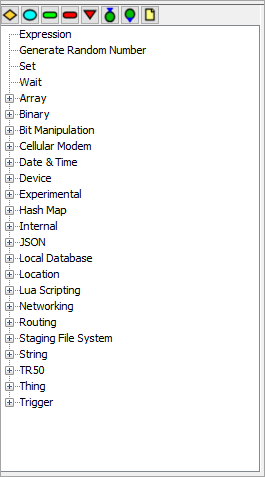The main concepts of a trigger are:
- The trigger's event type
- The trigger's local variables, static variables, macros and event variables
- The trigger's settings
- The trigger's actions, including the success and failure routes between actions.
Every trigger identifies the actions, which are the trigger's application logic. These actions range in complexity from actions such as formatting strings, or setting values, to more complex actions such as executing enterprise transactions or executing remote triggers.
While the actions defined in a trigger identify the application logic, the trigger event type identifies when the trigger will execute. The trigger event types are covered in the Trigger event type reference.
Assumptions
Before using information in this Trigger actions reference section, the following should have occurred:
- The Workbench is installed on a computer that has TCP connectivity to the node.
- You have a user ID and password to log on and use features of the Workbench.
- You understand how to create a trigger.
General trigger action concepts
The general project and trigger concepts are covered in the first few sections of Projects and triggers. Each action has a routing, which determines what action to go to next. The Canvas Editor and the List Editor have different mechanisms for defining each actions' routing. For more information, see Trigger actions.
Each trigger and each action has a Details tab where comments or information can be stored. For more information, see Trigger details.
Entering action parameter values
Each action has the specific parameters needed for the action to provide its function.
When a parameter can be specified by a device variable, trigger macro, constant, trigger local variable, trigger static variable or trigger event variable, the available options are displayed by clicking once in the Value cell for the parameter and then selecting the down arrow icon.
Only applicable options are displayed. For example:
- Macros and Constant do not apply for an output parameter
- Device variables are only available if the device is in a started state.
What's Inside
The organization of this Trigger actions reference
section is based on the hierarchy of the available actions
as displayed in the Workbench when defining a trigger, for
example:
The information in this Trigger actions reference section covers the different trigger actions available across the different products. The specific trigger actions available on a node depends on the type of product (for example: Enterprise Gateway vs. Asset Gateway), the features that are part of the product, and the packages or extensions installed on the node.
This guide contains the following: